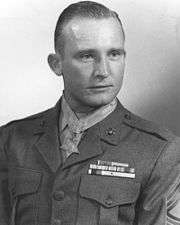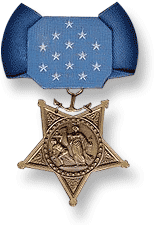Harold E. Wilson
| Harold Edward Wilson | |
|---|---|
  Medal of Honor recipient | |
| Born |
December 5, 1921 Birmingham, Alabama |
| Died |
March 29, 1998 (aged 76) Lexington, South Carolina |
| Place of burial | Woodridge Memorial Park, Lexington, South Carolina |
| Allegiance | United States of America |
| Service/branch | United States Marine Corps |
| Years of service | 1942–1945, 1947–1972 |
| Rank | Chief Warrant Officer |
| Unit |
3rd Battalion 1st Marines Marine Aircraft Group 13 |
| Battles/wars |
World War II Korean War -Battle of Chosin Reservoir Vietnam War |
| Awards |
Medal of Honor (1951) Bronze Star Purple Heart(x5) |
- For other persons with this name, see Harold Wilson (disambiguation).
Chief Warrant Officer Harold Edward Wilson (December 5, 1921 – March 29, 1998) was a United States Marine who earned the United States’ military highest award, the Medal of Honor, for heroism as a platoon sergeant of a rifle platoon in Korea on the night of 23-April 24, 1951. He received the award from President Harry S. Truman during ceremonies at the White House on April 11, 1952.
Wounded four times during the night-long battle, he refused medical treatment to rally his men against overwhelming Communist forces. With both arms virtually disabled, he continued to pass ammunition to the hard-pressed Marines and moved from foxhole to foxhole aiding and encouraging his men. When the assault was finally broken, he personally accounted for each of his men before walking a half mile unassisted to an aid station.
A month earlier, he had earned the Bronze Star for “fearless and untiring leadership” of his platoon in several engagements from 1-March 27, 1951. He had been wounded previously on December 9, 1950 during the Chosin Reservoir campaign.
Marine Corps service
Harold Edward Wilson was born on December 5, 1921 in Birmingham, Alabama, and attended Central Park Elementary and Ensley High School. He enlisted in the Marine Corps Reserve and was assigned to active duty on April 20, 1942. During World War II, he served overseas for 27 months and was stationed on Midway Island. In addition to his Pacific service, he was stationed at Parris Island, South Carolina; Camp Lejeune, North Carolina; and Portsmouth, Virginia. He was honorably discharged on October 20, 1945, with the rank of sergeant.
Two years later, he re-entered the Organized Marine Corps Reserve, joining the Birmingham unit. Recalled to active duty in August 1950 after the outbreak of the Korean War, he was assigned to Company G, 3rd Battalion, 1st Marines, 1st Marine Division. Arriving with his unit in Korea in November 1950, he participated in the Wonsan landing, and later fought in the Chosin Reservoir campaign and in the first United Nations counteroffensive. Following the 23-April 24, 1951 action in which he was wounded and earned the Medal of Honor, he was evacuated to the Yokosuka Naval Hospital in Japan and five months later returned to the United States. He was awarded a meritorious promotion to master sergeant in June 1951 and commissioned a Warrant Officer in August 1952. In December 1962, he assumed the post of Adjutant at the Marine Corps Engineer Schools, Camp Lejeune, and the following December was assigned to Force Troops, Fleet Marine Force, Atlantic, serving as Adjutant and Personnel Officer of the 2nd Tank Battalion.
Chief Warrant Officer Wilson was also a veteran of the Vietnam War, serving with Marine Aircraft Group 13 prior to being assigned as 6th Marine Corps District Personnel Officer in November 1968. He retired from the Marine Corps in February 1972.
Chief Warrant Officer Wilson died in Lexington, South Carolina on March 29, 1998. He is buried in Woodridge Memorial Park, Lexington, South Carolina.
Decorations and honor
A complete list of his decorations and medals includes: The Medal of Honor, the Bronze Star with Combat “V,” the Purple Heart with four Gold Stars indicative of five awards, two Presidential Unit Citations, the Good Conduct Medal, the Asiatic-Pacific Campaign Medal, the American Campaign Medal, the World War II Victory Medal, the National Defense Service Medal, the Korean Service Medal with three battle stars, the United Nations Service Medal, and the Korean Presidential Unit Citation.
| Medal of Honor | Bronze Star with Combat V | Purple Heart with four gold stars | Presidential Unit Citation with gold star |
| Marine Corps Good Conduct Medal | American Campaign Medal | Asiatic-Pacific Campaign Medal | World War II Victory Medal |
| National Defense Service Medal | Korean Service Medal with three bronze stars | United Nations Service Medal | Korean Presidential Unit Citation |
Medal of Honor citation
The President of the United States takes pleasure in presenting the MEDAL OF HONOR to
TECHNICAL SERGEANT HAROLD E. WILSON
UNITED STATES MARINE CORPS
for service as set forth in the following CITATION:
For conspicuous gallantry and intrepidity at the risk of his life above and beyond the call of duty while serving as Platoon Sergeant of a Rifle Platoon attached to Company G, Third Battalion, First Marines, First Marine Division (Reinforced), in action against enemy aggressor forces in Korea on the night of 23–24 April 1951. When the company outpost was overrun by the enemy while his platoon, firing from hastily-constructed foxholes, was engaged in resisting the brunt of a fierce mortar, machine-gun, grenade and small-arms attack launched by hostile forces from high ground under cover of darkness, Technical Sergeant Wilson braved intense fire to assist the survivors back into the line and to direct the treatment of casualties. Although twice wounded by gunfire, in the right arm and the left leg, he refused medical aid for himself and continued to move about among his men, shouting words of encouragement. After receiving further wounds in the head and shoulder as the attack increased in intensity, he again insisted upon remaining with his unit. Unable to use either arm to fire, and with mounting casualties among our forces, he resupplied his men with rifles and ammunition taken from the wounded. Personally reporting to his company commander on several occasions, he requested and received additional assistance when the enemy attack became even more fierce and, after placing the reinforcements in strategic positions in the line, directed effective fire until blown off his feet by the bursting of a hostile mortar round in his face. Dazed and suffering from concussion, he still refused medical aid and, despite weakness from loss of blood, moved from foxhole to foxhole, directing fire, resupplying ammunition, rendering first aid and encouraging his men. By his heroic actions in the face of almost certain death, when the unit's ability to hold the disadvantageous position was doubtful, he instilled confidence in his troops, inspiring them to rally repeatedly and turn back the furious assaults. At dawn, after the final attack had been repulsed, he personally accounted for each man in his platoon before walking unassisted one-half mile to the aid station where he submitted to treatment. His outstanding courage, initiative and skilled leadership in the face of overwhelming odds were contributing factors in the success of his company's mission and reflect the highest credit upon Technical Sergeant Wilson and the United States Naval Service.
/S/ HARRY S. TRUMAN
See also
References
 This article incorporates public domain material from websites or documents of the United States Marine Corps.
This article incorporates public domain material from websites or documents of the United States Marine Corps.
- "Chief Warrant Officer Harold Edward Wilson, USMC, Who's Who in Marine Corps History, History Division, United States Marine Corps.". Archived from the original on February 5, 2012. Retrieved September 29, 2010.
- "Medal of Honor citation". Archived from the original on July 13, 2007. Retrieved September 29, 2010.